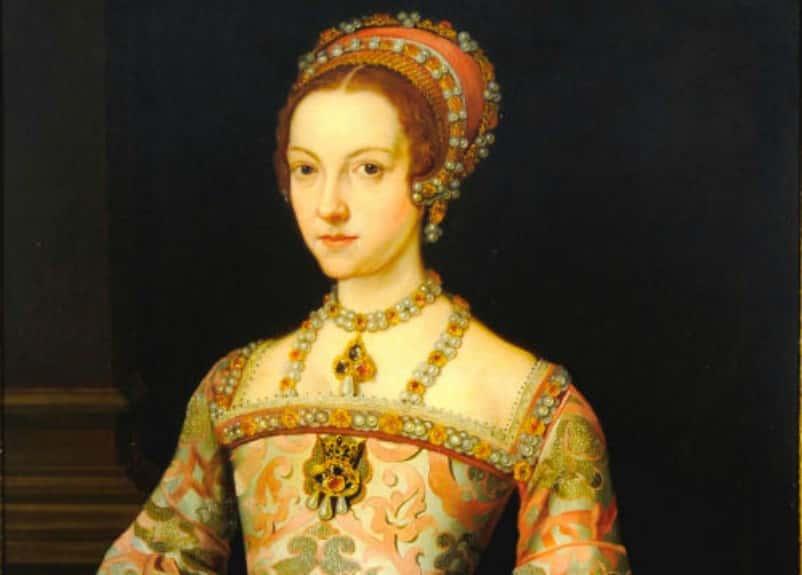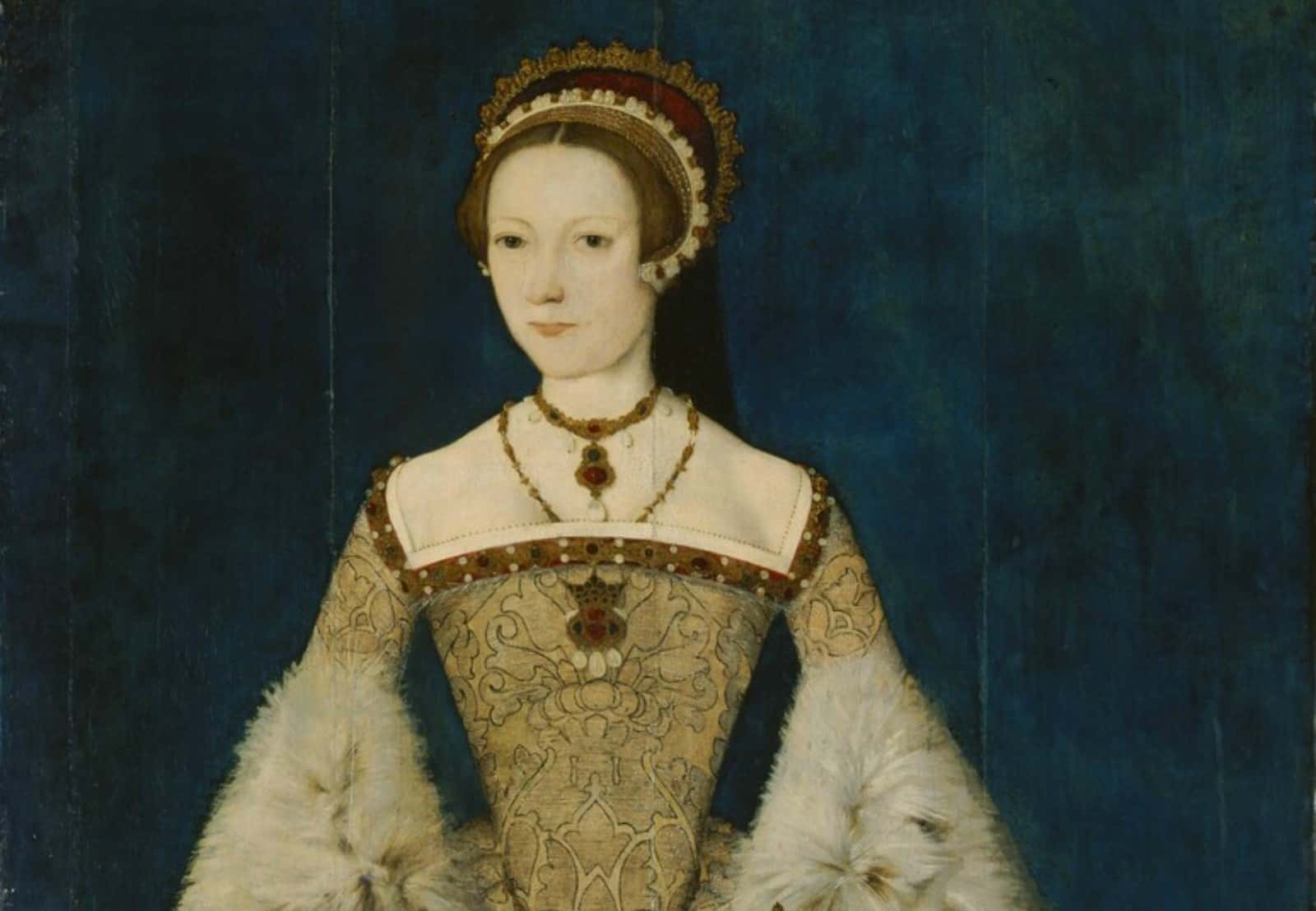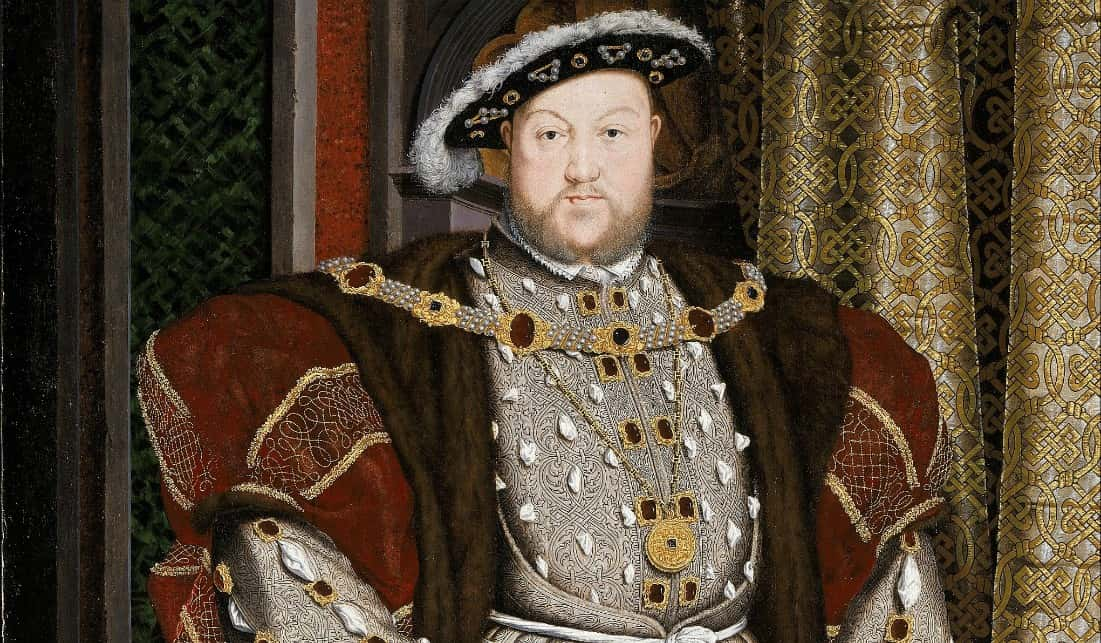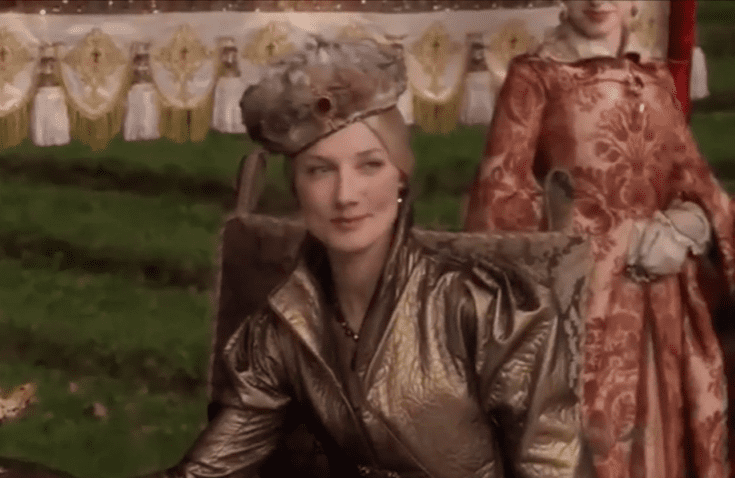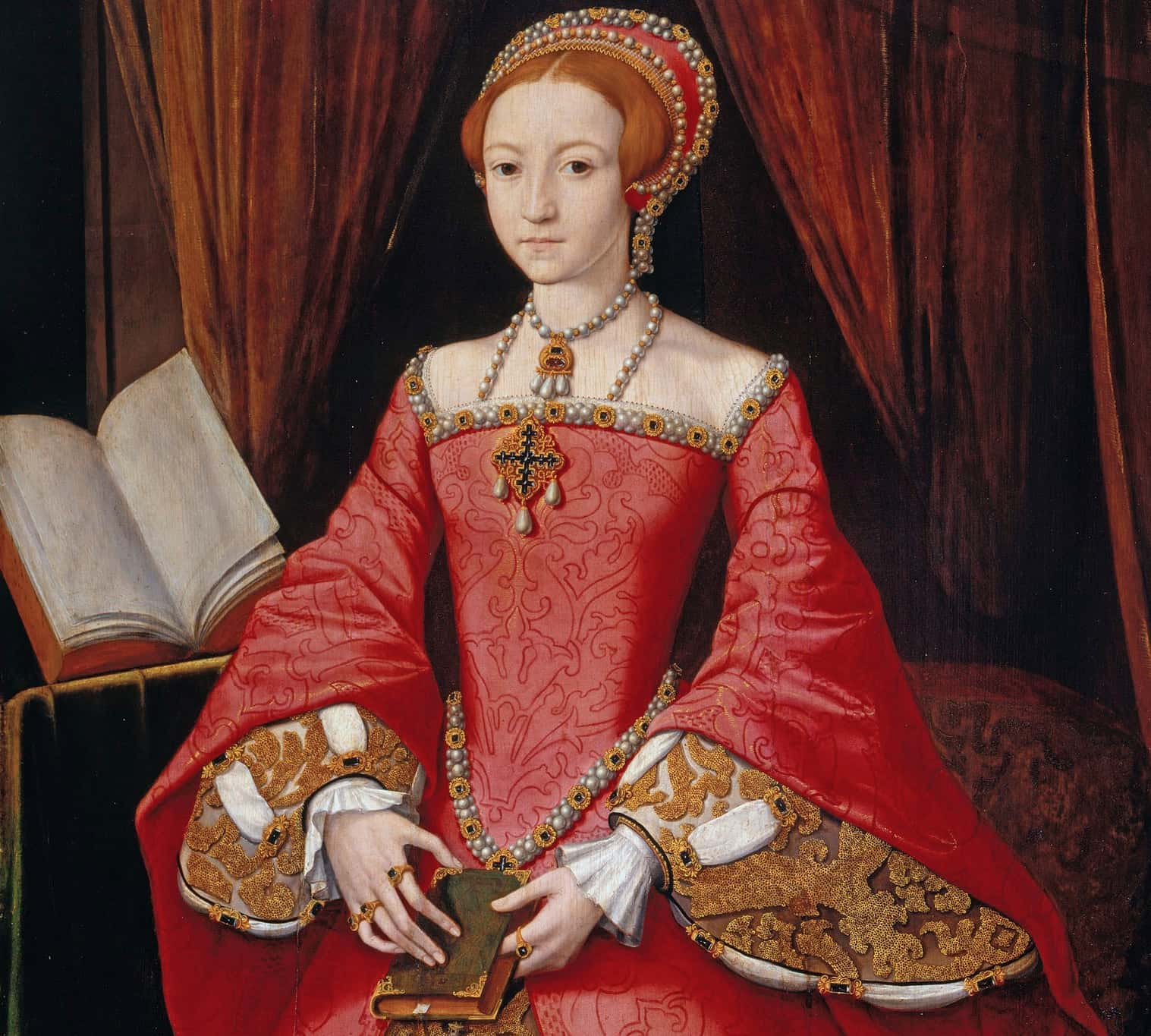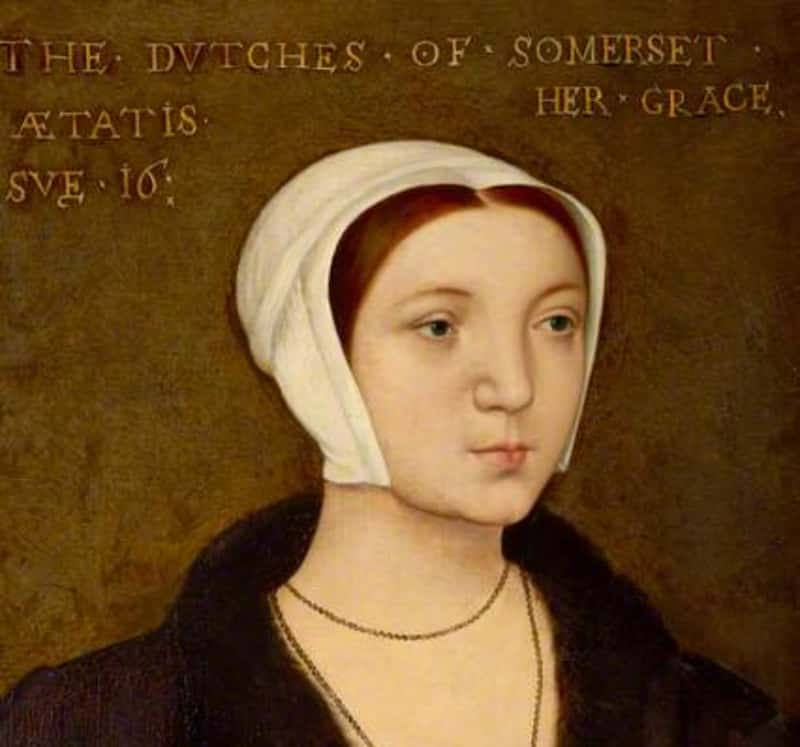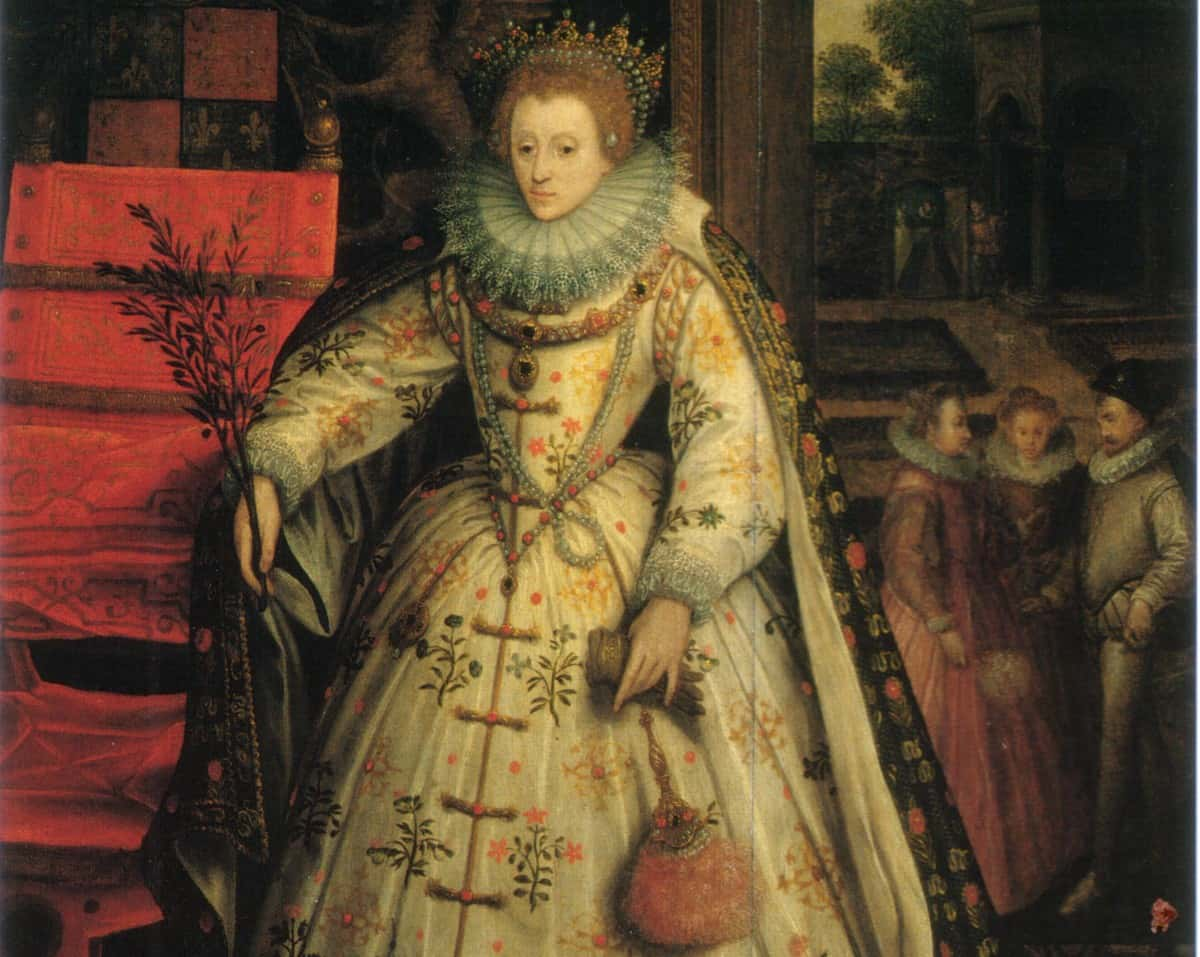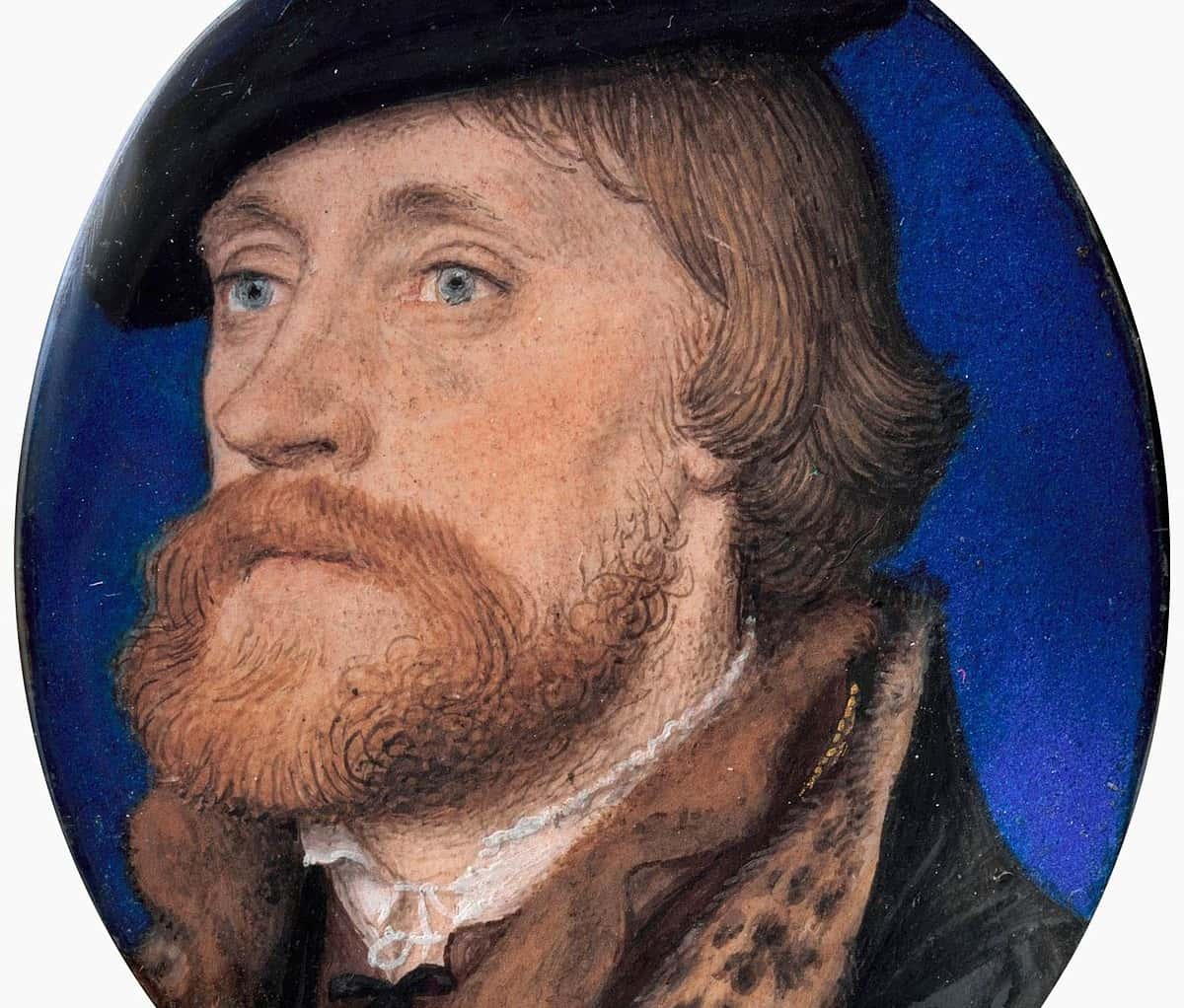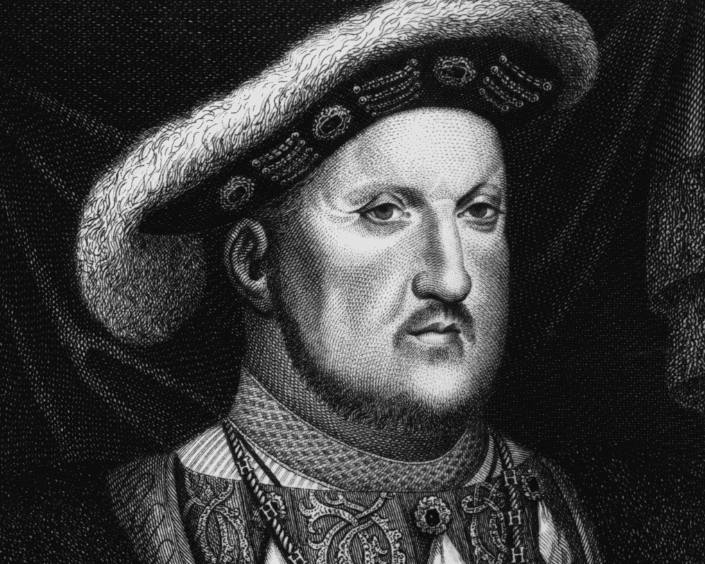Catherine Parr, The Last Wife Of Henry VIII
Only one woman was devious enough to outlast the notorious King Henry VIII—and that was the utterly scandalous Catherine Parr. Catherine's life—before and after Henry—was a romantic saga in its own right. Like it or not, though, Catherine Parr will forever go down in history as the "survivor" of Henry VIII.

1. Fourscore
Catherine Parr holds a unique, if somewhat dubious title. With four husbands under her bejeweled belt, Parr is England’s most-married queen. In that sense, Henry VIII, who was married six times, found his match when he met her.

2. Queen of the Bibliography
Catherine may be the "last" of Henry’s wives, but she has won "firsts" in English women’s literary history. For one, her Prayers or Meditations (1545) is the first book ever to be authored by English woman under her own name. Impressively, it is the first book to be openly published by a woman in the English language itself.
Earlier, Catherine had published an English translation of Latin psalms called Psalms or Prayers, but she had to do so anonymously.
3. In Every End is a Creepy Beginning
Catherine Parr had a bizarre connection to Henry VIII's first wife, Catherine of Aragon. She was likely named after her. Parr’s mother served as lady-in-waiting to the first Queen Catherine. In turn, the older queen served as godmother to baby Catherine. Thus, Henry VIII’s long marital career comes to a full and creepy circle.
4. I Learned It from You
Catherine Parr was raised as the eldest child of her formidable single mother, Maud Green. Her accomplishments certainly set an example for Catherine. A woman of apparently great intellect, Maud was entrusted by the queen to manage the court school. But when Catherine was only 5 years old, tragedy struck for the Parr family.
5. Survival School
In 1517, Sir Thomas Parr passed on and left Maud as a widowed mother to their three children. Despite her youth, Maud never remarried for fear of endangering her kids’ inheritance. Instead, Maud devoted the rest of her life to her children’s education and to snagging them advantageous marriages. It’s not a reach to speculate that Maud taught the "surviving" Queen of Henry VIII a lot about how to, well, survive.
6. Master of Tongues
Unsurprisingly, when you consider her mother ran the court school, Catherine was a lifelong learner. She had a passion for languages and was fluent in French, Latin, and Italian. Upon becoming Queen, Catherine took time to learn Spanish as well.
7. Who Needs Homework When You’re Gonna Be Queen?
When Catherine was just a young girl, she made an eerily prescient prediction about her future. The tale goes that, as a girl, Catherine hated the tedium of needlework; she would tell her mother, "My hands are ordained to touch crowns and sceptres, not spindles and needles".
8. Not to Be Confused with His Grandpa
At the age of 17, Parr made the first of her four marriages—but the union was doomed to a heartbreaking end. His name was Sir Edward Burgh and it should've been a fairytale romance. He was age-appropriate (which is more than can be said for her other marriages), from a wealthy family, and a knight. But sadly, he was also in poor health, and he passed just four years after they were wed.
At just 21, Parr was a young and childless widow, left to start all over again.

History's most fascinating stories and darkest secrets, delivered to your inbox daily.
9. Second Time’s the Charm
Just one year after becoming a first-time widow, Parr married John Neville, 3rd Baron Latimer, in 1534. Unlike her first husband, this one was independently wealthy and twice her age—which better aligns with the young serial widow image that’s come to be stuck with Catherine.
10. Trouble in Paradise
However, this marriage also thrust the young Parr into grave danger. During the 1536 Northern Uprisings, Parr and her stepchildren by her second husband were taken as hostages. The rebels informed Lord Latimer that he had to come back home, or they would kill Catherine and his children—but there was a dark twist.
11. Which Side Are You On?
Latimer somehow managed to persuade the rebels to let them go. While their return was a miracle, their easy release made many suspicious, including the king himself. Was Parr's husband really a victim or a co-conspirator with the Northerners? The wrong answer to that question had the potential for truly dire consequences.
If he really was a co-conspirator, the family’s lands would be forfeited, and they’d be left penniless.
12. Two Down, Two to Go
While no charges were laid against Lord Latimer, the damage was done. His reputation suffered irreparable harm, and the family escaped to the South to avoid the judgment of their peers. During this time, the king's chief minister, Thomas Cromwell, blackmailed Latimer, but upon Cromwell's passing, the Latimers returned home. Soon after, Lord Latimer fell ill.
He perished in 1543. Parr was once again a childless widow.
13. Will I?
Upon her second husband’s passing, Catherine Parr inherited guardianship of her stepdaughter, choice properties, and a handsome income. At 31 years old, Parr was finally rich enough to marry on her own terms—and she even met a man who seemed suitable, but it wasn't to be...
14. My Dad Thinks You’re Cute
Catherine Parr's mother had been a friend of Henry VIII's first wife, Catherine of Aragon. On top of that, when Parr was younger, she had been friends with Henry’s eldest daughter, Mary Tudor. Following her second husband's demise, Catherine renewed their friendship and found a place in her entourage her at court.
Parr was just four years older than Mary Tudor, and had even met Henry when she was a child, but that didn't stop him from scoping her out—and he liked what he saw.
15. Head and Shoulders Above Them All
In terms of notable features, Catherine Parr possessed bright hazel eyes and great height; according to some sources, she stood as tall as 5’10". Being very tall himself, perhaps Henry VIII liked the idea of finally seeing eye-to-eye with a companion.
16. Royal Book Club
Some spend the spoils of their rich widowhood at designer boutiques; others host salons of controversial religious debate. As Lady Latimer, Catherine took a huge interest in the Protestant beliefs and philosophies of the Reformation. Catherine’s spiritual and intellectual pursuits would be a huge influence on her writing and her younger stepchildren—but they would also later end up threatening her very life.
17. Move Over, Bozo
When Catherine Parr entered the social circles of Mary Tudor, she caught Henry VIII's eye—but that wasn't the only one she caught. The brother of Henry's third wife, Thomas Seymour, was also interested in Parr. They even went so far as to seriously discuss marriage—but Henry VIII had other ideas.
18. Pick One—Or I'll Pick for You
Seymour was, by all accounts, handsome, charming, and about Catherine’s age. On the other hand, Henry didn’t exactly have any of these qualities at that time, but his other attributes were hard to pass up. For Catherine, the smart choice won out over the passionate one, but a letter in which Catherine ultimately rejects Seymour indicates where her preferences laid.
She wrote, "[M]y mind was fully bent to marry you before any man I knew. Howbeit, God… made that possible which seemed to me most impossible".
19. Ya Snooze, Ya Lose
Despite the fact that his minister was blackmailing her husband, Henry VIII had his eye on Catherine Parr even before her second husband passed. Just two weeks before Lord Latimer , Henry sent her gifts of pleats and sleeves, in addition to stylish Italian gowns. Henry himself was old, but perhaps no less limber in securing what he wanted.
20. Two for the Price of One
Upon her marriage to Henry VIII on July 12, 1542—just four months after her second husband passed—Catherine Parr became the first Queen of England to also be titled Queen of Ireland. Henry had just adopted the title of Ireland’s King.
21. Bitter Much?
While Catherine Parr was Henry VIII's last wife, there was still another surviving wife lurking around: Anne of Cleves, wife #4, was alive, well-favored, and still living in England…but she did not like Catherine. While Anne had gotten along with wife #5 (Catherine Howard, who actually supplanted Anne), she weirdly didn’t think highly of #6.
Apparently, Anne didn’t think Parr was pretty enough to replace her and was said to have sniffed, "A fine burden Madame Catherine has taken upon herself!"
22. Wed to Give a Darn
Catherine Parr proved to be an adept nursemaid for Henry’s body and spirits. Not only did she soothe and attend to his leg ulcers herself, she also convinced him to finally ditch his vanity and embrace his reading glasses. No small feat for the wife of an unruly king.
23. Seal of Obedience
Catherine’s official badge featured a long-haired maiden rising from a large Tudor rose. Her official queen’s motto was "To Be Useful in All I Do".
24. Sowing the Seeds
As Queen, Parr's Protestant sympathies were readily apparent. Not only did she secure the release of several Protestant prisoners, she also placed leading Protestant scholars in the household of her stepson, Prince Edward, thereby ensuring a future for the Reformers. But these powerplays would have dark consequences down the line...
25. Learning From the Best
The future Elizabeth I of England was the stepchild to whom Catherine was closest and with whom she shared a love of learning and language. At 11 years old, Elizabeth gifted her father and stepmother with a translation of Catherine’s Prayers or Meditation in French, Italian, and Latin. Catherine would also take charge of Elizabeth’s welfare after Henry’s passing.
26. Come Together Over Me
Catherine famously brought Henry’s much-fraught royal family back together. Henry’s only surviving son, Prince Edward, took a shine to his latest stepmother. When he was only nine years old, he encouraged his stepmother’s efforts to improve her own Latin and also asked her to keep his Catholic sister Mary away from "evil" influences.
It’s generally believed that Catherine was a big influence in both Edward and Elizabeth Tudor’s Protestant learnings and leanings.
27. 7th Wife? More Like Six Degrees of Separation
While Catherine Parr and Henry VIII's marriage was pretty solid, those in Henry's court had gotten used to switching things up on the regular, what with the revolving cast of wives who had come before her. In 1546, there was a failed plot to replace her with a new queen—the king’s own daughter-in-law, Mary Howard, who had recently been widowed. But there was other dark planning afoot.
28. Big Fish in a Little Pond
Mary's brother had different plans for her. He wanted her to marry Thomas Seymour—Catherine Parr’s ex—and, from there, slide into the position of King Henry’s mistress. Small dating pool, huh?
29. Queen Academy
Before Henry VIII passed in 1547, he made many provisions for Catherine Parr's future. Among them was the decree that she should take custody of his youngest daughter, the 13-year-old Elizabeth Tudor. She also took another studious royal girl as her ward: the future "Nine Days Queen" Lady Jane Grey. Unknowingly, Catherine mentored two queens of England.
30. On Her Own
From July to September 1546, Henry waged one final conflict against France. At this point, he still held Catherine in high regard, as evident by her appointment to Regent in his stead. Not only that, but she was also entrusted to keep acting as Prince Edward’s Regent in the potential event of Henry’s demise. By all accounts, Catherine carried her office with skill and dignity.
It’s believed her stepdaughter Elizabeth, future Elizabeth I of England, was alongside her at this period and took notes on Catherine’s influence.
31. The Best Thanks Has £ Signs
In 1547, Henry VIII was finally nearing the end of his life, and his last tribute to Catherine Parr was heartbreaking. Henry thanked God for finally delivering him "so faithful a spouse". Most importantly, Henry showed his thanks by bequeathing Catherine a £7,000/year pension (millions of dollars a year in today’s money), plus the right to keep all of the queen’s jewels and clothes.
We should all express gratitude like Henry.
32. Don't Stray Too Far
On January 28, 1547, Henry VIII officially passed on and left Catherine as Queen Dowager. She was, of course, supposed to take care of his daughter Elizabeth, and presumably, stay close to her beloved stepson Edward VI—but instead, one scandalous decision tore the family apart.
33. Can’t Hardly Wait
Catherine Parr ended up having no role in the reign of her beloved stepson, Edward VI, partly because she scandalously married her "true" love, Thomas Seymour, less than four months after Henry’s passing. Hey, Henry was barely one to wait between his marriages. Why should she?
34. Little Miracles
At the age of 35 (and one year after Henry’s passing), Catherine became pregnant for the first known time. She hadn’t been able to get pregnant in any of her first three of her marriages, so this must have come as a welcome surprise for the career stepmother.
35. The Family Jewels
Widowhood wasn’t all bliss and bling. King Henry’s will left Catherine with the crown jewels. However, Catherine’s new brother-in-law, Lord Protector Edward Seymour, refused to hand them over because they were traditionally worn by the ruler of England’s wife. As England’s de facto ruler as Lord Protector, of course Edward Seymour gave them to his own wife, Anne Stanhope.
This soured the friendship between Catherine and Stanhope, but it also furthered her husband Thomas’s bitterness towards his older brother—Thomas perceived Catherine’s deprivation as a personal attack by his brother against him, of course.
36. Denial Ahead…
Thomas Seymour was supposed to be Catherine Parr's one true love, but their fairytale union soon turned into a living nightmare. Upon moving in with Parr, Seymour became inappropriate with her young stepdaughter, Elizabeth Tudor. Seymour would surprise the girl in bed at odd hours for horseplay and even tried to kiss her.
37. It's Not Just a River in Egypt
Initially, Parr brushed off his attention as innocent. As if to demonstrate his lack of harm, Parr sometimes joined in the "romps" and helped hold Elizabeth down as Seymour tickled her. But at one point, this ended with Seymour "playfully" cutting the girl’s dress to bits…
38. Not Suitable for Children
As Catherine advanced in her pregnancy, her husband’s attention to Elizabeth became increasingly inappropriate—until the situation finally exploded. In May 1548, the tension climaxed with Catherine finding Thomas Seymour and Elizabeth in an embrace. What exactly happened is ambiguous, but it certainly ended with 14-year-old Elizabeth being sent away from her favorite stepmother’s home.
39. For Your Own Good
Perhaps Elizabeth was sent away for her protection from Seymour, or to remove her as a third wheel in Catherine’s longed-for domestic bliss, or to preserve everyone’s reputation, or some combination of the three. In any case: while they had once been incredibly close, Catherine and Elizabeth would never see each other again.
40. Outlived, But Not by Much
Catherine Parr gave birth to her only child, Mary Seymour, in late August 1548—but what should have been the happiest day of her life soon turned dire. She suffered from postnatal complications and passed just eight days later, at the age of 36. Despite being known as "the one who survived," Catherine outlived Henry VIII by just less than two years.
But her story didn't end there...
41. So Much for Honoring Her Memory
Nobody stays single for long in this saga. After Catherine Parr’s passing, her fourth husband Thomas Seymour renewed his intent to marry her stepdaughter, Elizabeth. Apparently, Elizabeth was always his first choice, but the council denied his request before he "settled" for her rich stepmother, Catherine—what a classy dude.
In a confusing chain of events that belong on another list, Seymour’s plan to circumvent the council got botched so horribly that he ended up executed for treason on March 20, 1549—just six months after Catherine’s passing.
 Wikimedia Commons, Andrew Butko
Wikimedia Commons, Andrew Butko
42. A Lost Legacy
For centuries, the fate of Catherine’s only daughter, Mary Seymour, has been a compelling mystery. After her father’s execution, the six-month-old baby was taken in by her mother’s close friend—and rumored would-be replacement—Catherine Brandon, Duchess of Suffolk. The duchess chafed at the high expense of raising a queen’s daughter (and her noble household) and requested more funds from Seymour’s estate.
While Seymour’s lands were fully restored to Mary, she never had a chance to enjoy it.
43. Whatever Happened to Baby Mary?
The last mention of the baby relates to her second birthday; after that, she disappears from historical record. While some hopeful people think Mary grew up to wed and settle into a private life, most are in doubt. After all, could the daughter of Henry VIII’s last queen—even if by another man—descend that deeply into obscurity?
Catherine Parr’s only child most likely passed in infancy, a sad fate after the extreme lengths Parr had gone to in order to survive...
44. Playing the Game of Thrones
Let's go back to 1546, before Henry VIII passed. Catherine Parr knew about the fates of the wives who had come before her, and she knew was playing a dangerous game with Henry. In order to avoid his wrath, she had to hide a dark secret. Parr was a Protestant, pitting her directly against her husband.
45. Gotcha
In 1546, Lord Chancellor Thomas Wriothesley and the Catholic faction at court plotted to oust Catherine as a heretic. This involved implicating her with Anne Askew, an Evangelist who was herself under arrest for heresy and to whom Catherine was rumored to be sympathetic.
46. Say Her Name
Was a female Evangelist sacrificed to protect Catherine Parr? While being "questioned" for heresy, Anne Askew became the first woman on record to be ever a victim of persecution in the Tower of London. Many suspect that this was done so Askew would give up Parr and/or her close ladies-in-waiting as Protestant themselves.
In either case, it didn’t work, as Anne Askew was burned without ever implicating the Queen. But that didn’t spell the end of danger for Parr…
47. Agree to Disagree
Spousal disagreements shouldn’t end in arrest, but here we are. By 1546, Henry’s suspicions about Parr's radical beliefs were inflamed by some religious argument between them. Apparently convinced of her heresy, Henry signed a warrant for the arrest of his sixth wife.
48. Old Habits Die Hard?
As Parr's arrest warrant was drawn in 1546, rumors swirled that Henry’s wandering eye had resurfaced. Most scandalously, the alleged "other woman" was Catherine Brandon, née Willoughby—the widow of his late best friend who was also Catherine’s own good friend and lady-in-waiting. Nevertheless, the whispers came to naught; it’s generally agreed that, by this point, Henry’s carnal appetite might have bee too battered by life to cheat.
49. The Ultimate Hall Pass
So why didn’t Henry VIII go down as the king who executed half his wives? Parr was lucky; somehow, the warrant for her arrest managed to fall conveniently outside her door, perhaps planted by an ally. Thus, this queen got a life-saving heads-up that her condemned predecessors—such as Anne Boleyn and Catherine Howard—did not.
50. Little Old Me?
Armed with news of her impending arrest, Parr came up with a plan. She was able to defend herself from Henry’s rage with the ultimate weapons: complete self-deprecation and capitulation to his ego. The next time Henry talked religion with her, Catherine claimed she only argued with Henry in order to distract him from his festering leg wounds…but she also yearned for his wisdom.
51. A Convincing Argument
After all, Parr was in her own words "but a woman, with all the imperfections natural to the weakness of my [gender]". Despite her vigorous education and writing career, Parr would never assume to know better about religion than her husband. He bought it. After all, entering the dating scene again—especially at his current stage of health—would've been a bit much.
52. I Feel Like I’m Forgetting Something…
Despite his forgiveness of Parr, Henry didn’t have enough time (or will) to call off her arrest. The Lord Chancellor and guards came to follow through with the warrant against Parr while she was in front of the king himself. Henry angrily ordered them away with shouts of "Fool!", "Knave!", and other sick 16th century burns.
53. Free to Write Her Heart out
After Henry’s passing, Parr finally felt safe enough to come out as a full-blown Protestant. This is evident in her final 1547 book, Lamentations of a Sinner, in which she makes an argument for the then-radical doctrine of salvation based on faith alone. Such beliefs ran completely counter to the doctrine of the Catholic Church and (most fatally) Catherine’s late husband, Henry VIII.
Waiting until Henry’s demise to vocalize her full beliefs is understandable, if you considered what happened to his other wives.




